Good things come to those who wait! Our six-day trip canoeing the South Saskatchewan River Medicine Hat to Sandy Point – around 160 river kilometres – may have been delayed twice due to high water levels, but the third time was a charm. Read on for inside tips on paddling this prairie river in southeastern Alberta.
Disclosure: This post contains Affiliate links.
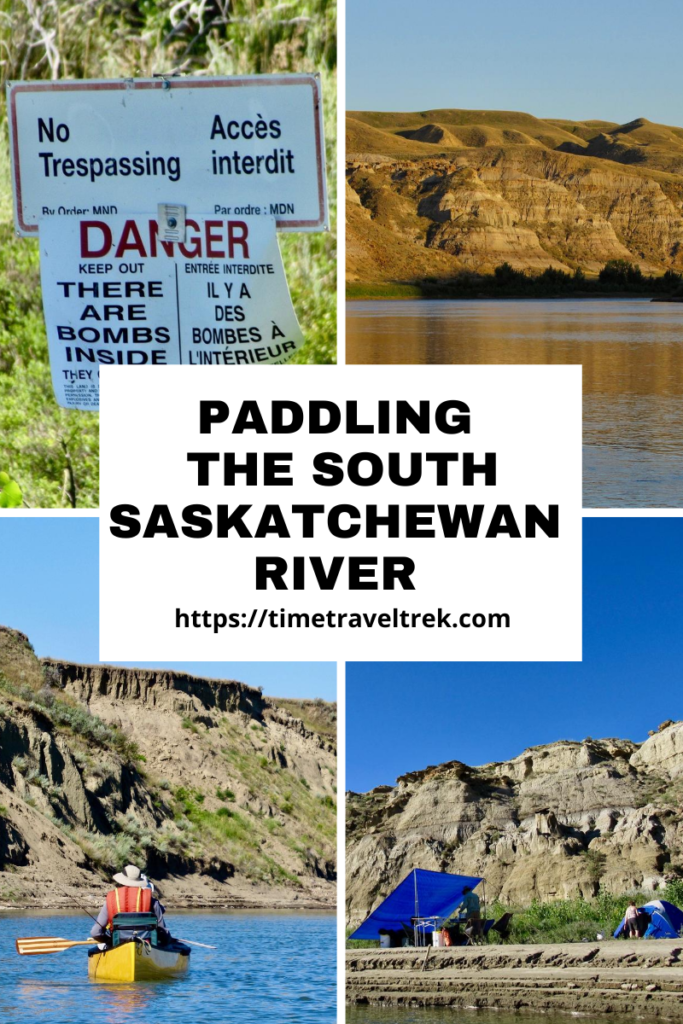
Table of Contents
Our Trip Canoeing the South Saskatchewan River
A few years ago we paddled from Bindloss Ferry to Estuary. This year we were canoeing the South Saskatchewan from Medicine Hat to Sandy Point. On the river late afternoon, we floated past jet skis, power boats and inflatable party rafts as we rounded Police Point on our north-easterly path to Sandy Point. Fishing rods were cast and the first day was spent drifting past countless water pumps sucking moisture for fields of cow corn.
Windmills popped up on the horizon and powerlines crisscrossed overhead. Our goal was just to get downstream out of town. After 18 km, we ended up pulling up on a river right sandbar for the night, setting up camp under a clear sky. We dubbed it the Mud Spa Camp – due to the tricky entrance and exit of the sandbar.
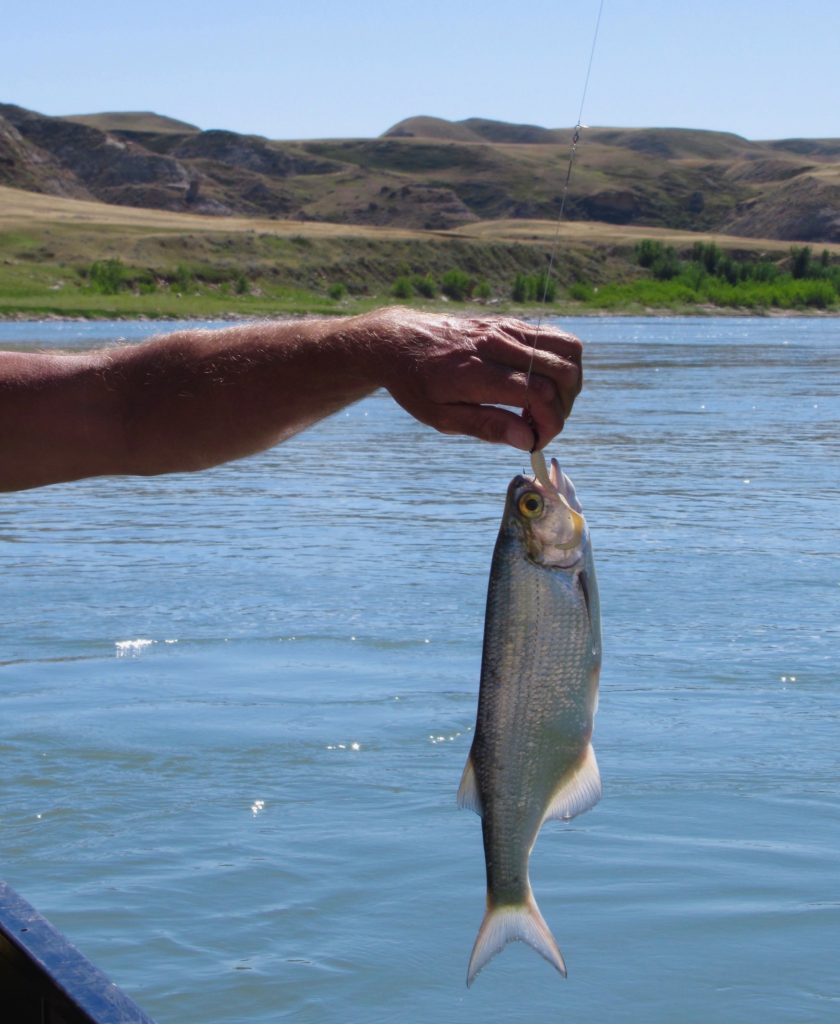
(Photo: Megan Kopp)
Paddle On
Day two was a 30 km paddle passing a jetboat loaded with anglers searching for sturgeon and another jet boat with a local rancher who wanted to make sure that we knew it was his land we were on when we stopped riverside to check out a potential campsite for the night. Settling in for a game of cards after dinner, we were smacked by a surprise wind as surrounding storms started gathering into a grand light show.
Cards flew in all directions as we raced to batten down the hatches. Winds were so strong that we couldn’t get the fly on our tent. We ended up crashing it and stowing it under a canoe, watching lightening shoot across boiling grey clouds tinged with sunset pink. Just before dusk, the winds died down enough to set our tent back up and for everyone to shake out the silt from their sleeping bags and mattresses. We dubbed this site Tornado Alley Camp.
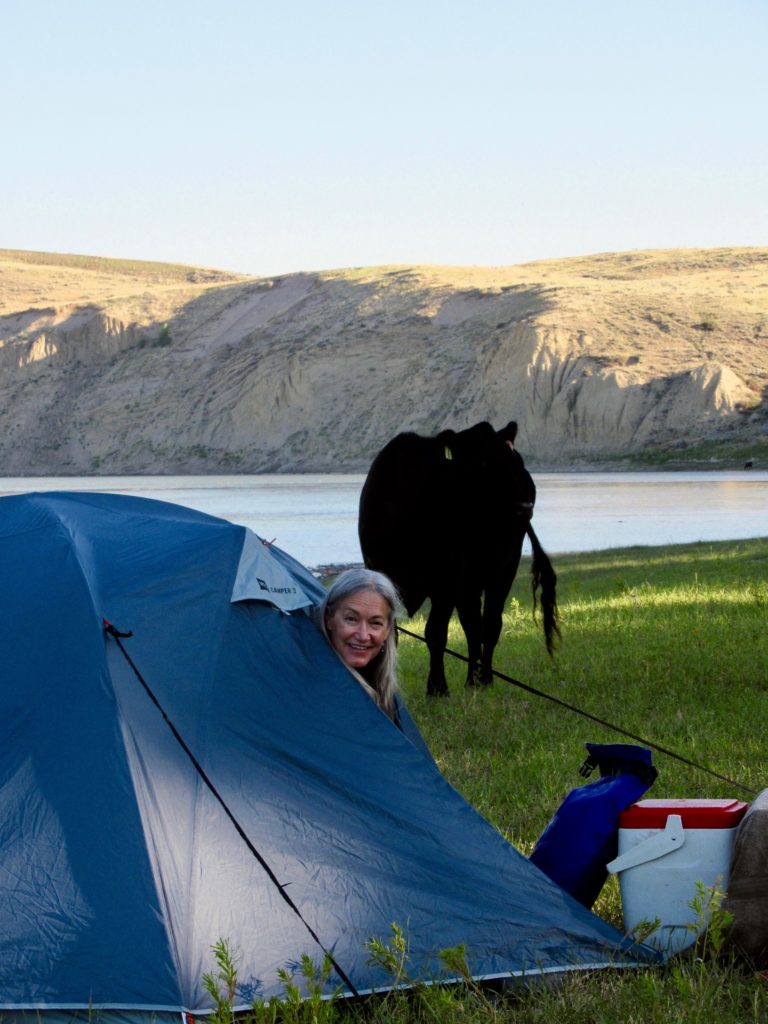
(Photo: Megan Kopp)
Halfway There!
The third day – another 30 km or so stretch – shone bright and clear. Civilization faded away as the landscape began showing scenic bits of badland. Eagles – both bald and golden – sat on shorelines, up on rock cliffs and in countless cottonwood snags. Pulling up camp at rough roadway on a grazing lease, we could just see the red guard shack high on the cliff where CFB Suffield starts to cover both sides of the river. Before 7 a.m. a local fisherman drove down to the river and launched for a day of sturgeon fishing. This site was duly named Boat Launch Camp.
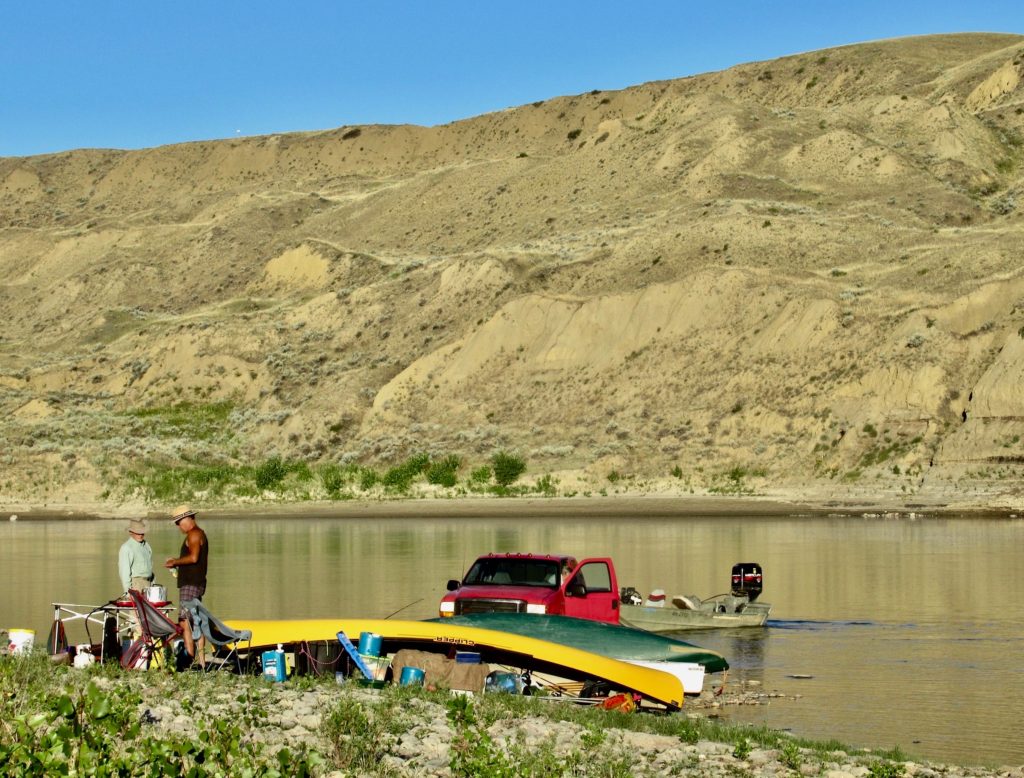
Heating Up
Day four was hot – smoking hot – as we drifted through the base, laughing at the warning signs totally ignored by cows grazing on prairie grasses. The rugged scenery was full of coulees and capstone-covered hoodoos. Straight ahead rocks formed a dark castle overlooking Rapid Narrows on river right. On the left, Murphy’s Horn stood like a thumbs up. We didn’t bother to scout the “rapids” as the water was low enough to be less than a Class I but still high enough to cover most of boulder field. Pulling out just below White Rock Coulee, we found a sandy bench that was aptly named Infinity Pool Resort Camp. Hours were passed jumping off the bank into the deep pool below, floating down and walking back upstream, stretching with a little yoga, and eating great food – of course.
Need some meal planning inspiration? Check out our canoe trip meals post!
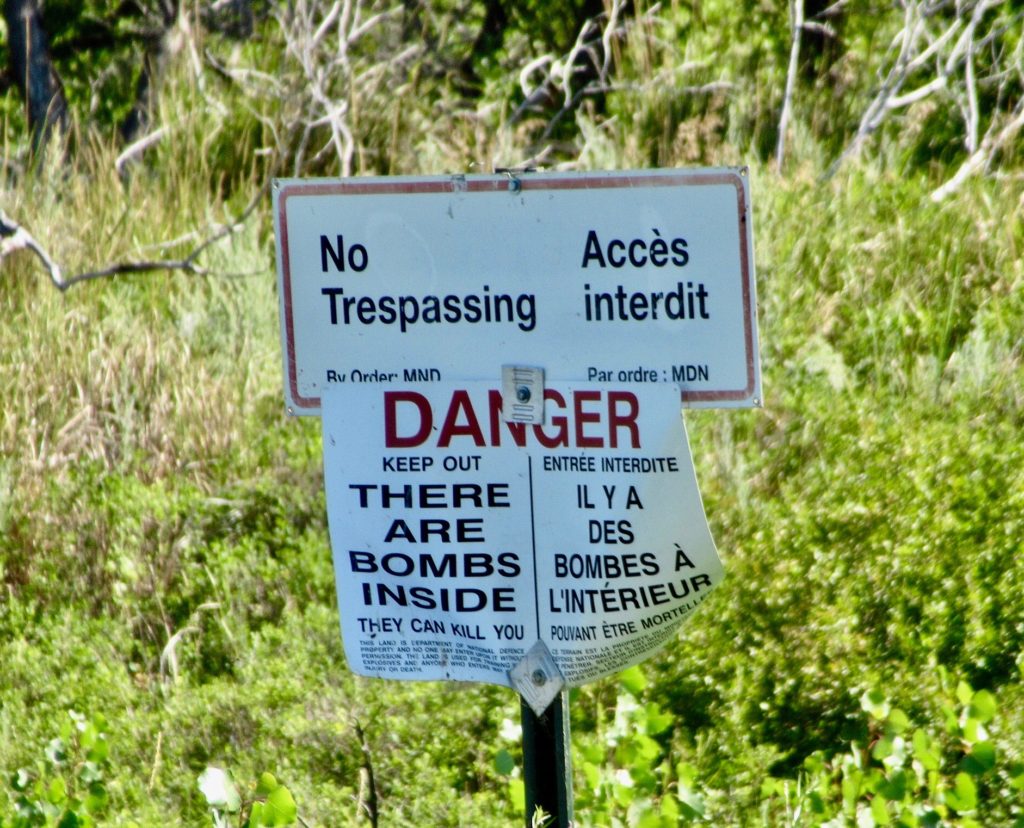
Final Stretches
The final full day on the river was about a 31 km paddle to just upstream of the old Bindloss Ferry site. A falcon flew overhead. Meadowlarks sang from the shore. Storm clouds threatened. Tents were firmly staked at camp and a shelter was set up to block the wind – which changed direction 180 degrees about an hour later! Down came the tarp now turned sail.
Before daylight, rain pelted the tents but thoughtfully stopped before we got up. The wind however kept blowing… and blowing… and… it was a sporty departure from Wind Camp. We made it to Sandy Point by 12:30 p.m. with the wind at our backs except for one short but memorable stretch where it slapped us in the face.
Who Should Paddle this Section of the South Sask?
Canoeing the South Saskatchewan River from Medicine Hat to Sandy Point is easy – for the most part. It is a good trip for most paddlers who have enough boat handling skills to avoid obstacles and enough strength to take on potentially strong upstream winds. Summer thunderstorms can come up quickly and sometimes require quick exits off the river. There are a few riffles, hidden rocks and one Class 1 rapid at Rapid Narrows.
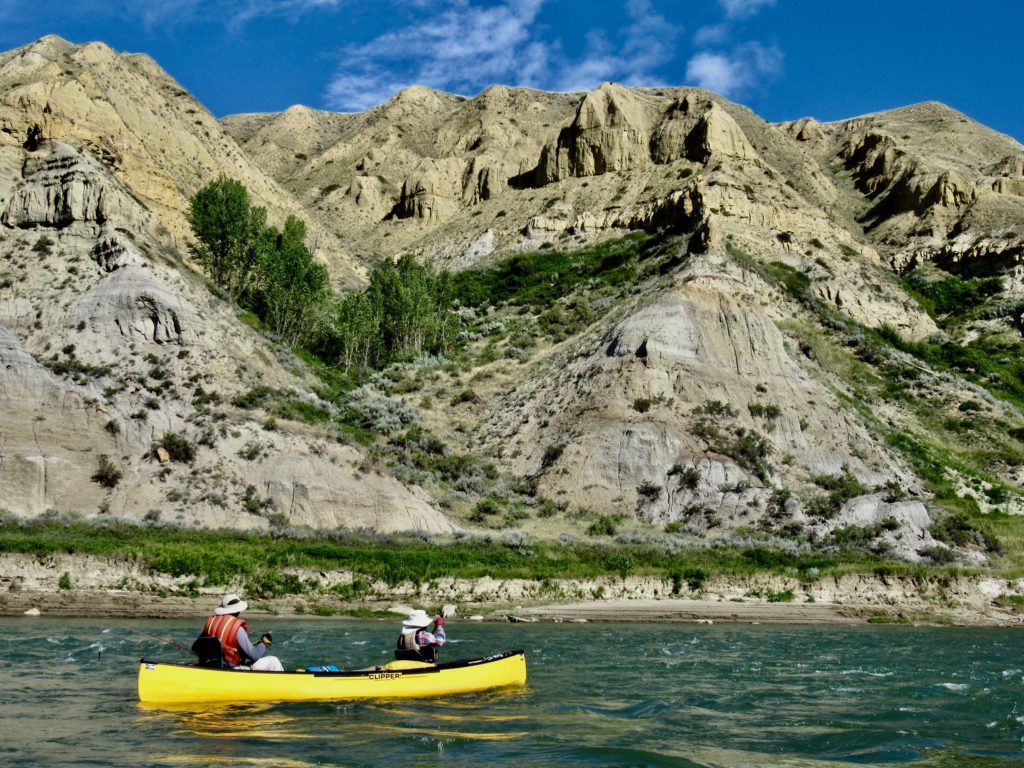
Prepping for a Six-Day Paddle
The first step is finding potential dates that work for your group. It helps – as we discovered – to be flexible with these dates. Next, discuss group gear and who is going to bring what (tarps, axe, stove, fuel, camp tables, emergency satellite messenger…).
Need outdoor clothing or gear? Check out MEC ⬇️
Canoeing the South Saskatchewan River from Medicine Hat to Sandy Point is a remote paddle. Once downstream of the last houses, there are very few access points. It’s critical to have all of the gear you need. Start with a good checklist.
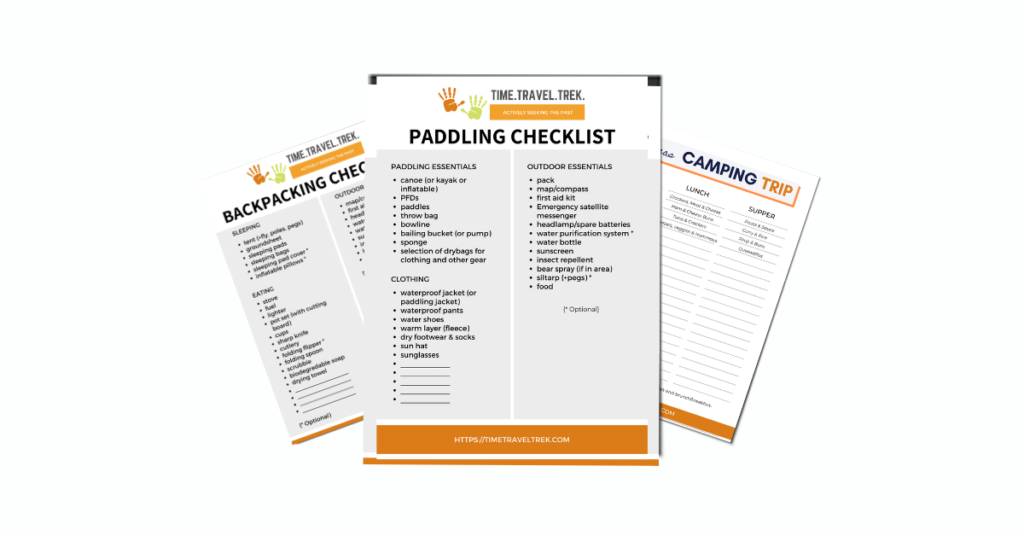
Feeding the Soul
Finally, sort out food. Our preference is for everyone to do their own lunches, snacks and beverages and go for group dinners and breakfasts. We were travelling with two other couples for six days. Because one couple were bringing a complete camp kitchen with stove and fuel, we agreed they’d do one breakfast and one dinner. The other two couples did two breakfasts and two dinners. It’s a good idea to toss around menu ideas so that you don’t end up with three spaghetti suppers in a row.
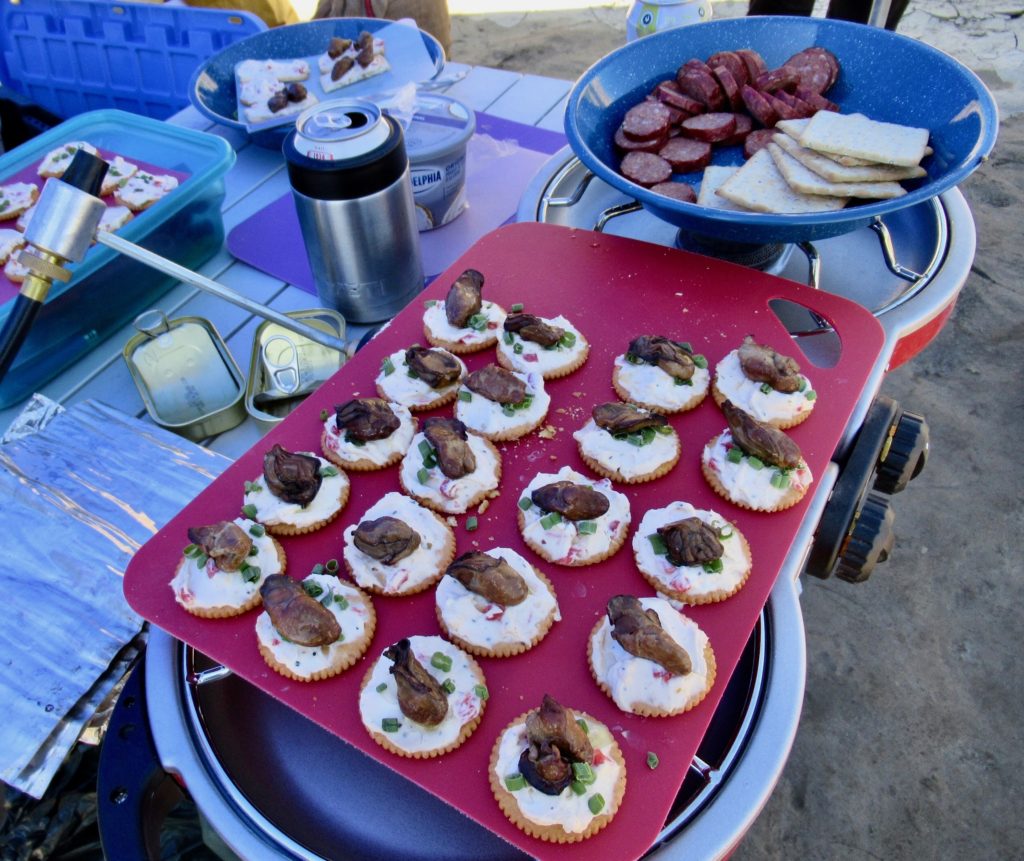
(Photo Megan Kopp)
Food for Thought
Sort out who will have which day for their meal (there’s a big difference in what you can pack for day one supper versus day five). I pre-cooked and froze the chicken and sausage for our day two Mediterranean Stew meal. We had the day five meal, which can be tricky for fresh food. I froze cheese tortellini and made a Terrific Tortellini meal with canned baby corn, fresh cherry tomatoes, zuchinni, mushrooms and red pepper in a white sauce topped with parmesan cheese. Desserts were made ahead of time and frozen. Appetizers are a nice bonus – crackers, cheese and meat boards work well. I lean towards goat cheese on crackers with homemade red pepper jelly and veggie pate and pretzels. Breakfast burritos and pan scrambles work well for breakfast, along with pre-made banana bread and orange or apple juice.
Reflecting After Dinner
Yes, we ate extremely well. Sitting riverside after dinner with a glass of port or sipping whisky or rum and pina coco, watching the beavers swim by to check us out as the sun sets on the hoodoos, we realized that on these canoe trips, feeding the soul is just as important as feeding the body.
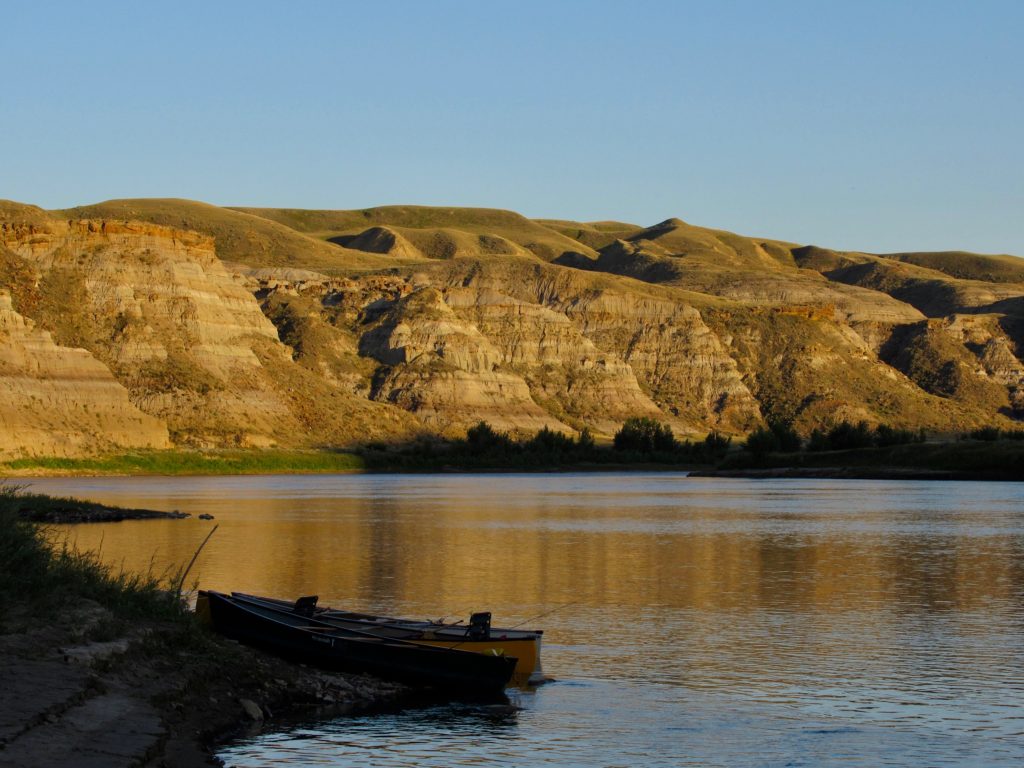
Cooler Hack: Take an old bath towel and drape wet over cooler; evaporation helps keep it stay cool longer. We use a Yeti cooler, which even in plus 30 C days kept everything cold for five days.
Setting up the Shuttle
We chose Strathcona Park in Medicine Hat as our launch point. It has a boat ramp with plenty of room to load three canoes as well as shade and washrooms for the waiting party while the vehicles are shuttled. Our takeout point was Sandy Point, about an hour drive from Medicine Hat. Check with campground host (if available) for best parking locations or find a good spot away from numbered campsites. We left two vehicles at the takeout.
The third vehicle came back to Medicine Hat and – on the advice of a helpful Medicine Hat Paddling Club member – was left in the old arena parking lot (behind the police station). It is about a one km walk from the old arena parking area along the paved path back downstream to Strathcona Park. Total shuttle time was around 2 ½ hours.
River Camping
The only public campground on the river in the stretch from Strathcona Park in Medicine Hat to Sandy Point is Sandy Point – at the very end of the paddle. Banks above the highwater mark are the property of farmers and ranchers, grazing associations and – for a large section in the middle – the Canadian Forces Base (CFB) Suffield. Be sure to choose campsites below highwater or on midstream islands.
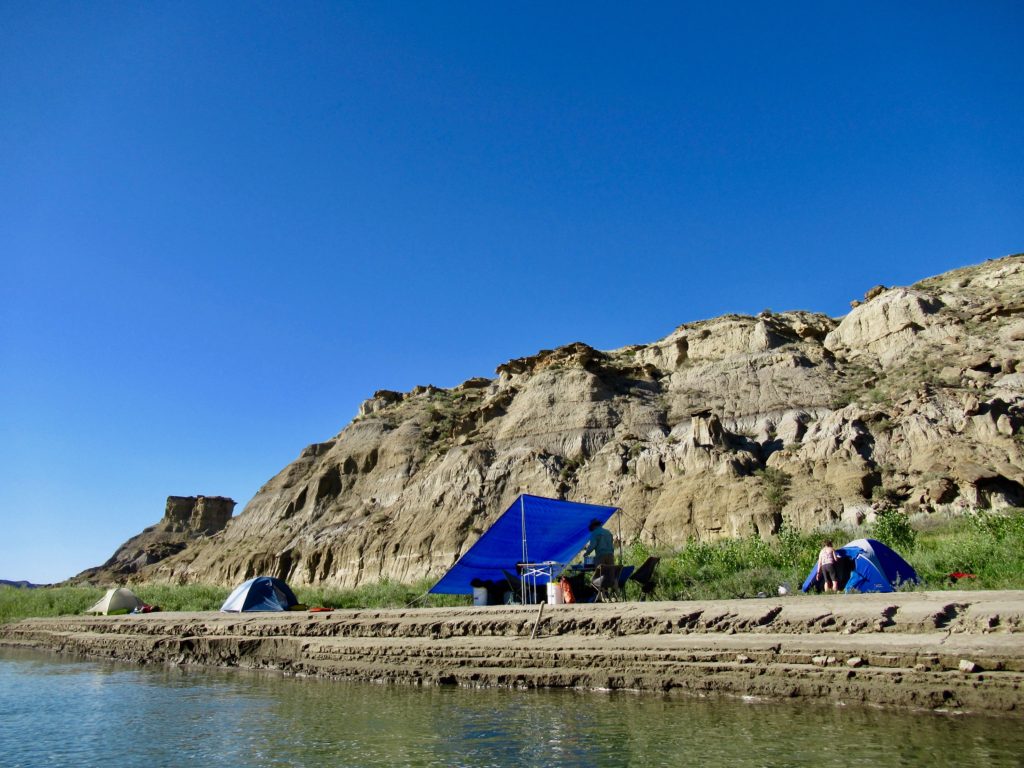
When we travelled the river, low flow rates provided ample options for setting up camp. High water will limit sites. Another note: if the water has been high, sandal-sucking mud will be an issue and biting insects will abound. It’s a good idea to wait for a couple weeks after high water before attempting the trip.
Additional Resources
- It’s important to note that canoeing the South Saskatchewan River in this section involves paddling through CFB Suffield. The Military occasionally shuts down river access during live training practices. Phone 403-544-4313 or 403-544-4310 to check schedules prior to your departure.
- Check out the Medicine Hat Paddling Club Facebook page.
- Read relevant section in Mark’s Guide for Alberta Paddlers.
- Buy a map or two or three!
- Check Alberta River Basins for South Saskatchewan River conditions and flow rates.
- Check weather forecast at Environment Canada.
- Looking for other paddling adventures in Alberta? Check out Paddling the Red Deer River or Canoeing the Oldman River: Monarch to Lethbridge or Paddling the Milk River in Spring.


Love this! Sounds like a beautiful paddle to try, great ideas for planning, and lots of info and links to make the trip less daunting for those who haven’t done this stretch of river before.
Thanks!
Glad you liked the post, Claudette. Making this trip “less daunting” for others who might wish to paddle the South Saskatchewan River was my main goal!
Can public vehicles access the “boat launch camp” location which I believe is here:
50°25’04.9″N 110°24’28.2″W
50.418033, -110.407827
just before rapid narrows?
I’m looking to do a shorter stretch. Thank you for the blog!
Sorry here: 50°25’05.3″N 110°24’28.8″W
We tried to figure out a way in, but not sure if roads run through a grazing lease or private property or if public could drive in. You might try contacting the Medicine Hat Paddling Club through their FB page – they are very helpful and have lots of great information!
Thanks for the descriptive and detailed report of your paddle. I appreciated the links and resources you add at the end. Enjoy your blogs on other trips as well.
Glad you are finding the information useful – paddle on!
Great stuff thank you.
Welcome!
Hello Megan, I attempted this trip leaving Strathcona boat launch this June 8th. Being a novice canoer and thinking lower water would be better at 65 m3s we couldn’t be more wrong. We made it to Ellis ranch on the left just before the base.(we could see the gaurdshack up ahead) Approx 50 km in 12 hours We exited the following morning as it was extremely hard to navigate the shallow sandbars and exposed rocks. Lots of exiting canoe to pull it over shallow sections. I was wondering if there is a flow rate you would recommend for this trip? I wasn’t able to see anything in your article. I’ve been told 100-200 m3s. I would like to try again and your article is great by the way.
Adventures turned misadventures always make for great stories – after the fact! Still, it’s always nice when you get to go back and finish what you started. I hope you get a chance to repeat the trip soon. As for flow rates, if you look under “additional resources” at the end of the article, I include a link to the Alberta River Basins for flow rates. We use this along with “Mark’s Guide for Alberta Paddlers” to figure out best flows for paddling. Just off the Oldman River with friends yesterday, our copy of Mark’s is AWOL at the moment, but I’ll get back to you on what is listed there a.s.a.p.
PS Checked the flow rates in “Mark’s Guide for Alberta Paddlers” and normal summer flows between 150-600 cms should provide good paddling.
Thank you for all the Information Megan. I will get familiar with the guide and the River basin website. Have a great summer 🙂